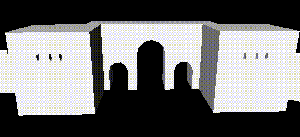 The Golden Gate
The Golden Gate
Located on the north side of the land walls, the Golden Gate is perhaps the most important part of the Theodosian walls. Though it is agreed that the Gate was built sometime between the reigns of the Byzantine Emperors Theodosius I (r. 379 - 395) and Theodosius II (r. 408 - 450), there is still controversy as to exactly when the gate was built and in what order. Two main theories can be supported: that the central arch of the gate was built first, possibly under the rule of Theodosius I, and that the two square towers flanking it were added later on when the walls were constructed; and that all three: the arch, towers, and walls were built at the same time, under the rule of Theodosius II. In a study of the Golden Gate during a recent trip to Istanbul, Jamie determined that structurally, the three sections are remarkably well integrated, an observation that lends strong support to the idea that the arch, towers and walls were all built at the same time. A historical study of that time, however, seems to suggest that Theodosius I had a much more concrete reason for building a triumphal arch, and so, at least for now, the origins of this mammoth structure remain shrouded in mystery.
 Creation of the Walls
Creation of the Walls
 During the spring and summer of 1996, Jamie Dunlop, a student at
Princeton University, undertook the modeling of the Theodosian
City Walls using Parametric Technology's Pro/ENGINEER software
package.
Dimensions of the walls were taken partly from first hand
measurements of the walls in present day Istanbul and partly from
various resources on the Princeton Campus. A generic template
wall section was created,along with two different representative
towers. These were then modified using Pro/E's parametric
capabilities and then placed along the perimeter of the city.
During the spring and summer of 1996, Jamie Dunlop, a student at
Princeton University, undertook the modeling of the Theodosian
City Walls using Parametric Technology's Pro/ENGINEER software
package.
Dimensions of the walls were taken partly from first hand
measurements of the walls in present day Istanbul and partly from
various resources on the Princeton Campus. A generic template
wall section was created,along with two different representative
towers. These were then modified using Pro/E's parametric
capabilities and then placed along the perimeter of the city.